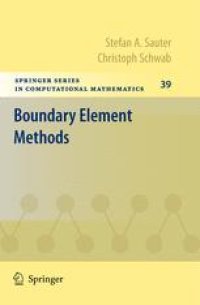
Ebook: Boundary Element Methods
- Tags: Computational Mathematics and Numerical Analysis, Partial Differential Equations
- Series: Springer Series in Computational Mathematics 39
- Year: 2011
- Publisher: Springer-Verlag Berlin Heidelberg
- Edition: 1
- Language: English
- pdf
This work presents a thorough treatment of boundary element methods (BEM) for solving strongly elliptic boundary integral equations obtained from boundary reduction of elliptic boundary value problems in IR3.
The book is self-contained, the prerequisites on elliptic partial differential and integral equations being presented in Chapters 2 and 3. The main focus is on the development, analysis, and implementation of Galerkin boundary element methods, which is one of the most flexible and robust numerical discretization methods for integral equations. For the efficient realization of the Galerkin BEM, it is essential to replace time-consuming steps in the numerical solution process with fast algorithms. In Chapters 5-9 these methods are developed, analyzed, and formulated in an algorithmic way.
This work presents a thorough treatment of boundary element methods (BEM) for solving strongly elliptic boundary integral equations obtained from boundary reduction of elliptic boundary value problems in IR3.
The book is self-contained, the prerequisites on elliptic partial differential and integral equations being presented in Chapters 2 and 3. The main focus is on the development, analysis, and implementation of Galerkin boundary element methods, which is one of the most flexible and robust numerical discretization methods for integral equations. For the efficient realization of the Galerkin BEM, it is essential to replace time-consuming steps in the numerical solution process with fast algorithms. In Chapters 5-9 these methods are developed, analyzed, and formulated in an algorithmic way.
This work presents a thorough treatment of boundary element methods (BEM) for solving strongly elliptic boundary integral equations obtained from boundary reduction of elliptic boundary value problems in IR3.
The book is self-contained, the prerequisites on elliptic partial differential and integral equations being presented in Chapters 2 and 3. The main focus is on the development, analysis, and implementation of Galerkin boundary element methods, which is one of the most flexible and robust numerical discretization methods for integral equations. For the efficient realization of the Galerkin BEM, it is essential to replace time-consuming steps in the numerical solution process with fast algorithms. In Chapters 5-9 these methods are developed, analyzed, and formulated in an algorithmic way.
Content:
Front Matter....Pages i-xvii
Introduction....Pages 1-19
Elliptic Differential Equations....Pages 21-100
Elliptic Boundary Integral Equations....Pages 101-181
Boundary Element Methods....Pages 183-287
Generating the Matrix Coefficients....Pages 289-352
Solution of Linear Systems of Equations....Pages 353-402
Cluster Methods....Pages 403-465
p-Parametric Surface Approximation....Pages 467-516
A Posteriori Error Estimation....Pages 517-544
Back Matter....Pages 545-561
This work presents a thorough treatment of boundary element methods (BEM) for solving strongly elliptic boundary integral equations obtained from boundary reduction of elliptic boundary value problems in IR3.
The book is self-contained, the prerequisites on elliptic partial differential and integral equations being presented in Chapters 2 and 3. The main focus is on the development, analysis, and implementation of Galerkin boundary element methods, which is one of the most flexible and robust numerical discretization methods for integral equations. For the efficient realization of the Galerkin BEM, it is essential to replace time-consuming steps in the numerical solution process with fast algorithms. In Chapters 5-9 these methods are developed, analyzed, and formulated in an algorithmic way.
Content:
Front Matter....Pages i-xvii
Introduction....Pages 1-19
Elliptic Differential Equations....Pages 21-100
Elliptic Boundary Integral Equations....Pages 101-181
Boundary Element Methods....Pages 183-287
Generating the Matrix Coefficients....Pages 289-352
Solution of Linear Systems of Equations....Pages 353-402
Cluster Methods....Pages 403-465
p-Parametric Surface Approximation....Pages 467-516
A Posteriori Error Estimation....Pages 517-544
Back Matter....Pages 545-561
....